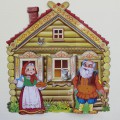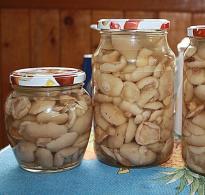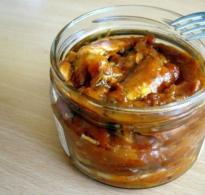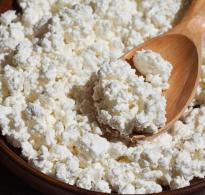Lesson notes mushrooms preparatory group. Summary of a lesson on familiarization with the outside world in the middle group “Mushrooms”
Goal: To consolidate knowledge about mushrooms and berries, their features appearance, places of growth. Activate vocabulary on the topic. Develop attention, thinking, visual perception. Development of general and fine motor skills, coordination of speech with movement. Foster respect for the environment. Develop cognitive interest.
Progress:
1. Limiting torque:
Guys, you know that our earth on which we live is round. The earth revolves around the sun and therefore the seasons have their own sequence. After winter comes spring, then summer, autumn.
The game is being played All year round» Children stand in a circle, taking turns clapping the names of the seasons, observing the sequence.
2. Subject message:
Today we are going to the forest.
We walked into the forest, walked, and came to a clearing.
Hello, dense forest, full of fairy tales and miracles...
Meets Lesovichok with a basket of mushrooms and berries.
Mushrooms are unusual plants; they have no branches, no leaves, no flowers. (look at the picture). What do mushrooms have? Leg, cap, roots-mycelium. Fungi reproduce by spores. Spores are small particles that hide in the caps of mushrooms. When the mushrooms ripen, the spores fall to the ground. Young mushrooms grow from the spores. Through roots - strings, mushrooms receive water from the ground and useful substances. People who go into the forest to pick mushrooms are called mushroom pickers. Edible mushrooms are very tasty and healthy. They can be boiled, fried, pickled, dried.
3. “Who grows where”
Each mushroom has its own home where it grows. White boletus mushroom grows in pine and spruce forests. They grow up as families. Butterflies grow in the pine forest; the cap of the oiler is slippery, as if it were greased with oil. What mushroom did we find under the aspen tree? Which one is under the birch tree? But chanterelles grew in the thick grass - red chanterelles. Oh, what kind of miracle is this - a stump? All covered with mushrooms. These are honey mushrooms, they are growing large families on stumps.
In the clearing we saw beautiful mushroom: red with white spots. This is a fly agaric. When the fly agaric gets old, the edges of its cap will bend upward and it will turn into a saucer. If it rains, there will be water left in the saucer. Not simple - poisonous. A fly drinks this water and dies. That's why they call it Muho-mor.
4. Finger gymnastics “For mushrooms”
Top top. Five steps, there are five mushrooms in the little bag.
Red fly agaric is a dangerous mushroom.
And the second one is a fox, a red-haired sister
The third mushroom is the volnushka, pink ear.
And the fourth mushroom is the morel, the bearded fatty.
The fifth mushroom is white, eat it boldly.
5. “Riddles and riddles”
Lesovichok places pictures of mushrooms on a flannelgraph.
Listen to my riddles and quickly give me the answers.
This mushroom lives under the spruce tree, under its huge shadow.
Wise bearded old man, resident of the forest - ... (boletus)
I'm wearing a red cap, growing among the aspen roots.
You will see me a mile away - my name is ... (boletus)
The brothers are sitting on a stump. All of them are freckled naughty girls.
These friendly guys are called... (honey mushrooms)
In the forest, to the delight of people, among the young pines,
A fungus grows in a shiny dark cap... (oil can)
In thin dresses, girlfriends dance in a circle at the edge of the forest.
Dresses – striped silk: red, white, pink, satin.
On an autumn day at the edge of the forest, how beautiful you are... (waves)
They wear red berets, bringing autumn to the forest in summer.
Very friendly sisters - golden... (chanterelles)
Near the forest on the edge, decorating the dark forest,
It grew up as colorful as Parsley, poisonous... (fly agaric)
Look, guys: here are chanterelles, there are honey mushrooms
Well, these are poisonous ones in the clearing... (toadstools)
6. Physical exercise “Raspberries”
And now I invite you to the raspberry farm. (To the music, children stand in a circle, sing a song and perform movements according to the lyrics of the song)
7. Berries are small juicy fruits of shrubs and herbaceous plants. (pictures of berries are placed on the flannelgraph). What do berries have? Root, stem, leaves and fruits. Strawberries love a lot of light, so they can be found in sunny meadows. Lingonberries are collected on dried bog hummocks. Cranberries grow in a swamp.
Little children are sitting under the leaf on each branch.
The one who gathers the children will smear his hands and mouth. (Blueberry)
We will bend down to the ground to fill the boxes.
We move the stems apart - we collect the lights. (Strawberry)
I am red and sour, I grew up in a swamp.
Ripened under the snow, Come on, who knows me? (Cranberry)
Red beads are hanging, looking at us from the bushes.
Children, bees and bears love these beads very much. (Raspberries).
8. Summary. Generalization.
So our journey into the forest has come. I give you my box. We picked a lot of berries and mushrooms here. Come and visit the forest again. But remember simple rules picking berries and mushrooms.
Do not pick or trample poisonous mushrooms - forest inhabitants need them.
Cut the mushrooms carefully so as not to damage the mycelium.
Do not pull out berry bushes.
Collect only familiar berries and mushrooms.
Goodbye guys.
Like 2 Bad 0
Firyuza Khusainova
Summary of educational activities on environmental education in the preparatory school group “Children of the Forest: Mushrooms, Berries”
INTEGRATION OF EDUCATIONAL AREAS:"Cognitive", "Social-communicative", "Artistic-aesthetic".
TASKS:"Educational" - Introduce children to diversity mushrooms and berries growing in forests middle zone Russia.
To form an idea of the basic precautions that must be observed when collecting them.
“Social-communicative” - teach children to distinguish wild plants berries from garden, edible mushrooms from inedible.
“Artistic and aesthetic” - Consolidate knowledge of the features of the external appearance of gifts forests.
METHODS AND TECHNIQUES:
verbal-conversation, questions;
visual - showing illustrations and pictures;
practical - didactic game. modeling
PRELIMINARY WORK - getting to know the forest through watching TV shows, reading books, excursions to the nearest park, working with parents, reading literature.
MATERIAL:pictures depicting edible and inedible mushrooms, berries, dummies mushrooms,posters with images mushrooms and berries, plasticine, modeling boards, stacks, napkins.
METHODS AND FORMS of organized educational activities:
Game - didactic game, sedentary game.
Communicative - conversation, questions, speech situations.
Perception fiction - storytelling.
Fine - modeling.
LOGIC of educational activities.
TEACHER.
- Children. we all love salted mushrooms, fried, marinated. A mushroom soup ? And pies with mushrooms? But we all know how to behave in the forest when collecting mushrooms to make these "delicious" children" forests Did they please not only you, but also other people, and not only now, but also in a few years? After all, life itself short mushroom: two or three days and that’s it. A the mycelium lives long. sometimes more than ten years. that's why we have to remember the rule first: mushrooms cannot be pulled out of the ground - it will cause harm mycelium. They must be cut very carefully with a knife.
Have mushrooms and another enemy is cars. buses and other types of transport. which emit exhaust gases into the atmosphere and can “infect” them mushrooms. Hence the rule follows second:cannot be collected mushrooms near the highway.
Look carefully at these pictures. Which mushrooms can it be collected and used for food? That's right - boletus(they grow under birch and aspen trees (look what beautiful hats they have - these were worn in the old days by brave guardsmen, saffron milk caps (the best mushrooms for pickling, white (they are collected not only by people, but also by squirrels for the winter, boletus.
But these are inedible mushrooms(I show them in pictures and on slides and tell them that some of them are poisonous. People often knock them down with their feet, trample them, but to do this it is forbidden: They serve as food and sometimes medicine for many forest inhabitants.
-Here is the third rule: do not tear, knock down or trample inedible mushrooms- they will be useful to animals and birds.
Let's play the game "Collect mushrooms".
But the forest children, rich not only mushrooms, but also berries. (I tell the story, showing pictures. slides about forest berries: raspberries, strawberries, blueberries, lingonberries - where they grow, what they are useful for).
You see how much joy and benefit there is from these fragrant and sweet “children” forests. How can you multiply their harvest and save it for other people?
Remember when collecting forest berries, be careful. do not tear the bushes yourself, do not break the branches. don't trample the grass.
After the conversation, I will conduct a didactic game “What do we take in the basket.”
At the end of the lesson I will invite the children to do some modeling mushrooms and berries.
CHILDREN'S ACTIONS.
Children listen to the teacher, answer questions in complete sentences. Remember the rules of behavior in the forest. Look at the slides. pictures. illustrations about mushrooms and berries. Play a sedentary game of collecting edibles mushrooms for speed,play a didactic game according to the rules. They sculpt mushrooms and berries made of plasticine.
RESULT.
Children remember the rules of conduct in the forest. Strengthened your knowledge about mushrooms and berries. We learned about the benefits of poisonous mushrooms, about the benefits berries. in games they also consolidated the acquired knowledge, in modeling they consolidated knowledge about appearance mushrooms and berries.
Publications on the topic:
1. Review with your child natural vegetables, fruits, mushrooms and berries. If possible, tell us about them, what they cook and where they grow. 2. Draw.
Summary of the group gathering in the senior group “Forest, berries, mushrooms” Tasks: 1. Create an emotional mood for the whole day. 2. Create conditions for interpersonal and cognitive-business communication between children and adults.
Summary of an open speech therapy lesson in a preparatory group on the development of lexical and grammatical categories and coherent speech. Theme "Mushrooms".
Abstract of educational activities for cognitive development in the senior group “Forest. Mushrooms. Berries" Topic: Forest. Mushrooms. Berries. Goals: 1. Expand children's understanding of the forest and trees: coniferous and deciduous; expand children's ideas.
 Speech development. Development of the lexical and grammatical structure of speech. Topic: “Forest. Mushrooms. Berries" Goal: To systematize children's knowledge about the forest.
Speech development. Development of the lexical and grammatical structure of speech. Topic: “Forest. Mushrooms. Berries" Goal: To systematize children's knowledge about the forest.
Maria Buzaeva
Summary of a lesson on familiarization with the outside world in middle group"Mushrooms"
Tasks: -expand children’s understanding of mushroom(name, place of growth, structure); form ability to distinguish between edible and inedible mushrooms. Strengthen your ability to solve riddles. ( « Cognitive development» )
Activate children's vocabulary (names mushrooms) . ("Speech development")
Foster respect for nature and friendliness ( "Social and communicative development")
-form ability to paint over a drawing with shading ( « Artistic and aesthetic development")
Develop gross motor skills ( "Physical development").
Progress of the lesson:
1. The teacher draws the children’s attention to a basket covered with a scarf, which he holds in his hands. She asks if they want to know what's inside it? But to do this you need to solve the riddle.
In the forest under the Christmas tree there is a baby -
Just a hat and a leg.
Children solve the riddle and find out what's in the basket mushrooms.
2. The teacher suggests going on a trip to the forest, turns on an audio recording "Sounds of the Forest". Conducts a physical education session “We sat down under a bush”
We sat down under a bush,
To find fungus.
We got up. They pulled the back.
We walk along the path again. (Squats.)
Now let's turn the knobs
It's like we're clearing away the clouds.
We drive them back and forth
Twelve times in a row. (Rotation of straight arms back and forth.)
We squat lower, deeper,
Like a frog in a warm puddle.
Jump - and there is no mosquito!
Here's a fun game. (From a deep squat, jump up.)
Relaxed and frolicked
And they sat down on the chairs. (Children sit down.)
3. The teacher asks the children to sit in a semicircle and introduces the children to world of mushrooms(presentation « Mushrooms» , story based on the plot).
Children get acquainted with different types mushrooms, remember their names and place of germination. Find out if they can be eaten.
4. The teacher asks with what they met through mushrooms? Which ones do they particularly remember? Offers to decorate the fly agaric with colored pencils, while clarifying it external signs. Children express their opinion about what they see, color mushroom hatching.
Publications on the topic:
Theme of the week: “Autumn” (mushrooms, berries) (from 7.09 to 1 Monday Date 09.07.2015 Joint activity with children of SDD (independent activity.
Summary of educational activities for physical education and cognitive development in the preparatory group “Preparation for space flight” Synopsis of an integrated educational activity on FMEP and cognitive development in the preparatory group On the topic: “Preparation for space flight” Educator.
Summary of educational activities for cognitive development in the preparatory group of the kindergarten “Friends with Sports” Goal: Introducing children to physical education and sports, to a healthy lifestyle. Program objectives 1. Cognitive development Consolidate.
Summary of educational activities for cognitive development in the middle group “Water and its properties” Goal: have an idea of the properties of water (fluidity, smell, taste, color) Objectives: Educational 1. To introduce the properties of water (fluidity,...
Educational goals: Clarification and expansion of ideas about tableware, its purpose, and the materials from which it is made. Formation of concepts.
Objectives: -continue to develop children’s interest in the plant world; - consolidate knowledge of names indoor plants; - clarify ideas.
Notes on cognitive development in the middle group “Number series” Goal: learn to compose a number series; teach orientation in spatial situations; learn to identify a pattern based on comparison.






